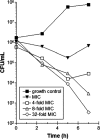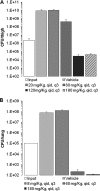Novel bacterial NAD+-dependent DNA ligase inhibitors with broad-spectrum activity and antibacterial efficacy in vivo
- PMID: 21189350
- PMCID: PMC3067096
- DOI: 10.1128/AAC.01181-10
Novel bacterial NAD+-dependent DNA ligase inhibitors with broad-spectrum activity and antibacterial efficacy in vivo
Abstract
DNA ligases are indispensable enzymes playing a critical role in DNA replication, recombination, and repair in all living organisms. Bacterial NAD+-dependent DNA ligase (LigA) was evaluated for its potential as a broad-spectrum antibacterial target. A novel class of substituted adenosine analogs was discovered by target-based high-throughput screening (HTS), and these compounds were optimized to render them more effective and selective inhibitors of LigA. The adenosine analogs inhibited the LigA activities of Escherichia coli, Haemophilus influenzae, Mycoplasma pneumoniae, Streptococcus pneumoniae, and Staphylococcus aureus, with inhibitory activities in the nanomolar range. They were selective for bacterial NAD+-dependent DNA ligases, showing no inhibitory activity against ATP-dependent human DNA ligase 1 or bacteriophage T4 ligase. Enzyme kinetic measurements demonstrated that the compounds bind competitively with NAD+. X-ray crystallography demonstrated that the adenosine analogs bind in the AMP-binding pocket of the LigA adenylation domain. Antibacterial activity was observed against pathogenic Gram-positive and atypical bacteria, such as S. aureus, S. pneumoniae, Streptococcus pyogenes, and M. pneumoniae, as well as against Gram-negative pathogens, such as H. influenzae and Moraxella catarrhalis. The mode of action was verified using recombinant strains with altered LigA expression, an Okazaki fragment accumulation assay, and the isolation of resistant strains with ligA mutations. In vivo efficacy was demonstrated in a murine S. aureus thigh infection model and a murine S. pneumoniae lung infection model. Treatment with the adenosine analogs reduced the bacterial burden (expressed in CFU) in the corresponding infected organ tissue as much as 1,000-fold, thus validating LigA as a target for antibacterial therapy.
Figures






Similar articles
-
Mechanistic assessment of DNA ligase as an antibacterial target in Staphylococcus aureus.Antimicrob Agents Chemother. 2012 Aug;56(8):4095-102. doi: 10.1128/AAC.00215-12. Epub 2012 May 14. Antimicrob Agents Chemother. 2012. PMID: 22585221 Free PMC article.
-
Identification and characterization of an inhibitor specific to bacterial NAD+-dependent DNA ligases.FEBS J. 2008 Nov;275(21):5258-71. doi: 10.1111/j.1742-4658.2008.06652.x. Epub 2008 Sep 13. FEBS J. 2008. PMID: 18795946
-
Discovery of bacterial NAD+-dependent DNA ligase inhibitors: optimization of antibacterial activity.Bioorg Med Chem Lett. 2011 Aug 1;21(15):4556-60. doi: 10.1016/j.bmcl.2011.05.128. Epub 2011 Jun 12. Bioorg Med Chem Lett. 2011. PMID: 21719282
-
Discovery and Optimization of NAD+-Dependent DNA Ligase Inhibitors as Novel Antibacterial Compounds.Curr Pharm Des. 2017;23(14):2117-2130. doi: 10.2174/1381612822666161025145639. Curr Pharm Des. 2017. PMID: 27784238 Review.
-
Microbiological profile of telithromycin, the first ketolide antimicrobial.Clin Microbiol Infect. 2001;7 Suppl 3:2-10. Clin Microbiol Infect. 2001. PMID: 11523558 Review.
Cited by
-
First In Vitro-In Silico Analysis for the Determination of Antimicrobial and Antioxidant Properties of 2-(4-Methoxyphenylamino)-2-oxoethyl Methacrylate and p-Acetamide.ACS Omega. 2024 Feb 9;9(7):7910-7922. doi: 10.1021/acsomega.3c07836. eCollection 2024 Feb 20. ACS Omega. 2024. PMID: 38405536 Free PMC article.
-
The protective role of commensal gut microbes and their metabolites against bacterial pathogens.Gut Microbes. 2024 Jan-Dec;16(1):2356275. doi: 10.1080/19490976.2024.2356275. Epub 2024 May 26. Gut Microbes. 2024. PMID: 38797999 Free PMC article.
-
The Search for Herbal Antibiotics: An In-Silico Investigation of Antibacterial Phytochemicals.Antibiotics (Basel). 2016 Sep 12;5(3):30. doi: 10.3390/antibiotics5030030. Antibiotics (Basel). 2016. PMID: 27626453 Free PMC article.
-
Biochemical and Structural Characterisation of DNA Ligases from Bacteria and Archaea.Biosci Rep. 2016 Oct 6;36(5):00391. doi: 10.1042/BSR20160003. Biosci Rep. 2016. PMID: 27582505 Free PMC article.
-
Naphthalimides Selectively Inhibit the Activity of Bacterial, Replicative DNA Ligases and Display Bactericidal Effects against Tubercle Bacilli.Molecules. 2017 Jan 17;22(1):154. doi: 10.3390/molecules22010154. Molecules. 2017. PMID: 28106753 Free PMC article.
References
-
- Azoulay-Dupuis, E., et al. 1991. Antipneumococcal activity of ciprofloxacin, ofloxacin and temafloxacin in an experimental mouse pneumonia model at various stages of the disease. J. Infect. Dis. 163:319-324. - PubMed
-
- Balani, S. K., et al. 2004. Effective dosing regimen of 1-aminobenzotriazole for inhibition of antipyrine clearance in guinea pigs and mice using serial sampling. Drug Metab. Dispos. 32:1092-1095. - PubMed
-
- Benson, E. L., et al. 2004. A high-throughput resonance energy transfer assay for Staphylococcus aureus DNA ligase. Anal. Biochem. 324:298-300. - PubMed
MeSH terms
Substances
LinkOut - more resources
Full Text Sources
Other Literature Sources
Medical
Molecular Biology Databases
Research Materials

